
Cannaregio is the northernmost of the six historic sestieri (districts) of Venice. It is the second largest sestiere by land area and the largest by population, with 13,169 people as of 2007.

Palazzo Labia is a baroque palace in Venice, Italy. Built in the 17th–18th century, it is one of the last great palazzi of Venice. Little known outside of Italy, it is most notable for the remarkable frescoed ballroom painted 1746–47 by Giovanni Battista Tiepolo, with decorative works in trompe-l'œil by Gerolamo Mengozzi-Colonna.

Andrea Tirali was an Italian architect working in Venice and the Veneto. He was responsible for the intricate design of the pavement in the Piazza San Marco in Venice.

The Cannaregio Canal is one of the main waterways of Venice, Italy.

The Palazzo Cendon is a minor 15th-century palace recognized by some as a small palace by 1501 in Venice, Italy, located just off the southern promenade of the Cannaregio Canal, about 200 feet east of Rio della Crea.
Currently it is used as a Residence de Charme.

Palazzo Corner della Regina, commonly known as Ca' Corner della Regina, is a Baroque-style palace in the Sestiere Santa Croce of the city of Venice, Italy. In the English language, the title conforms with Palace of the Queen from the "Corner Family"; it is so named because Caterina Cornaro, who became Queen of Cyprus by marriage, was born to this family and at this site in 1454. The palace is located on the Grand Canal, near Ca' Pesaro, and between Ca' Favretto and Palazzo Correggio. The opposite structure is Palazzo Contarini Pisani.
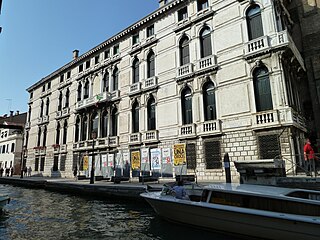
The Palazzo da Lezze or Ca' Lezze is a Baroque palace in Sestiere of Cannaregio in the city of Venice, Italy. It is located on Rio della Misericordia, with a facade on the fondamenta (canal-sidewalk), and stands between the Scuola Grande Nuova della Misericordia and Calle Largo Lezze.

The Palazzo Manfrin Venier, once known as the Palazzo Priuli a Cannaregio or Palazzo Priuli Manfrin, is a Baroque-style palace located facing the Cannaregio Canal in the sestiere of Cannaregio of Venice, Italy. It stands to the left of the Palazzo Savorgnan.

Palazzo Nani is a Renaissance palace in the Cannaregio district of Venice, Italy.
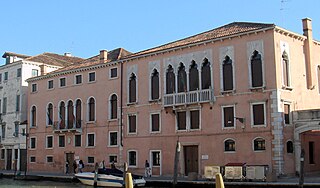
Palazzo Testa is a small Gothic palace in Venice, Italy, located in the Cannaregio district and overlooking the Canale di Cannaregio.
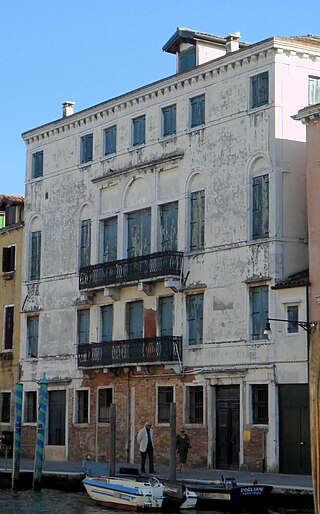
Palazzo Bonfadini Vivante is a palace in Venice, Italy located in the Cannaregio district and overlooking the Cannaregio canal. The neighboring buildings are Palazzo Savorgnan and Palazzo Testa.
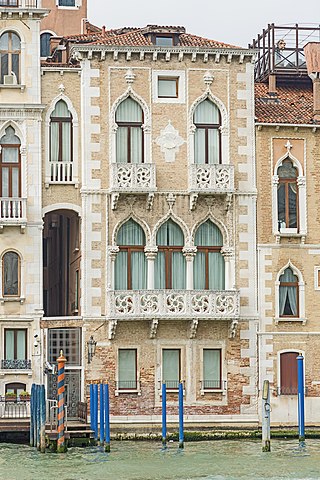
Palazzo Contarini Fasan is a small Gothic palace in Venice, Italy, located in the San Marco district and overlooking the Grand Canal. The palazzo is also called the House of Desdemona.

Palazzo Correr Contarini Zorzi is a Renaissance palace in Venice, Italy, overlooking the Grand Canal and locating in the Cannaregio district between Palazzo Querini Papozze and Palazzo Gritti. The palazzo is also known as Ca' dei Cuori, a family whose wrought iron coats of arms is present on the façade.

Palazzo Donà Balbi is a palace in Venice, Italy, located in the Santa Croce district, overlooking the right side of the Grand Canal on the Riva di Biasio foundation opposite Palazzo Flangini and the church of San Geremia.

Palazzo Falier is a civil building located in Venice, Italy in the Cannaregio district. The palazzo is particularly known for having been the home of Marin Falier, Doge of the Republic of Venice, who was executed for attempting a coup d'état.

Palazzo Smith Mangilli Valmarana is a palace in Venice, located in the Cannaregio district and overlooking the Grand Canal. The neighboring building is Palazzo Michiel del Brusà.
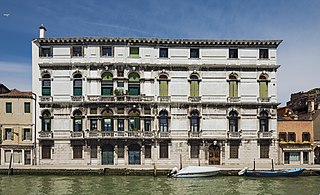
Palazzo Surian Bellotto is a Baroque palace in Venice, Italy. The palazzo is located in the Cannaregio district and overlooks the Cannaregio Canal.
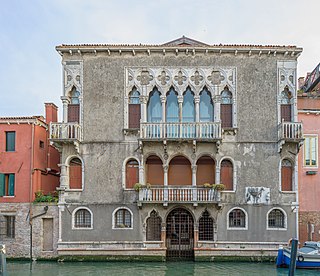
Palazzo Mastelli del Cammello is a Gothic palace in Venice, Italy. It is located in Cannaregio district, on the Campo dei Mori and the Rio Madonna dell'Orto.
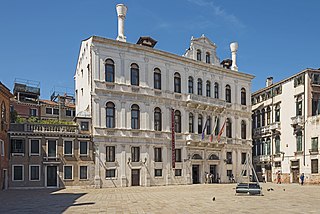
Palazzo Priuli Ruzzini Loredan, also called Palazzo Loredan at Campo Santa Maria Formosa, is a late 16th-century palace located at Campo Santa Maria Formosa in the Castello district of Venice, northern Italy, characterised by features of Renaissance and Baroque-style architecture on its façades.

Palazzo Bolani Erizzo is an ancient Venetian palace of the 13th century, built along the Grand Canal in the Cannaregio district. It stands wall to wall with Palazzo Dolfin.






















